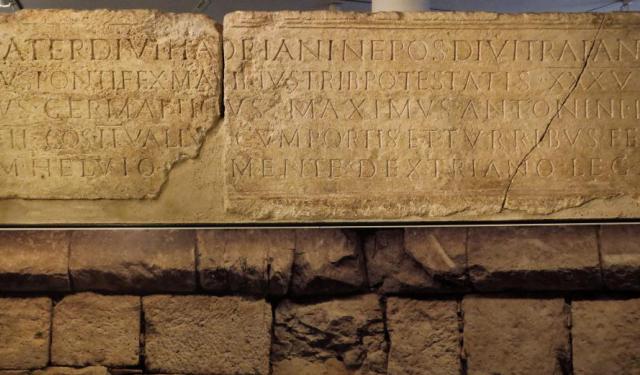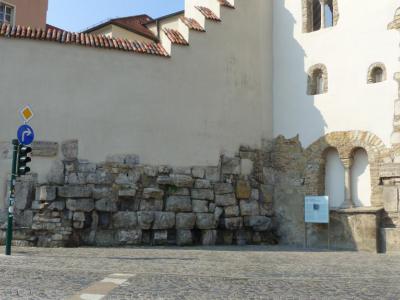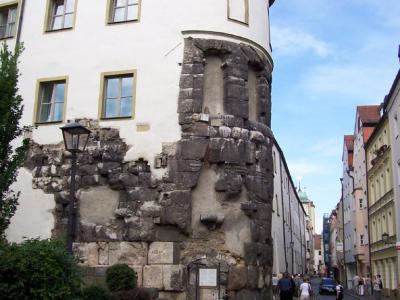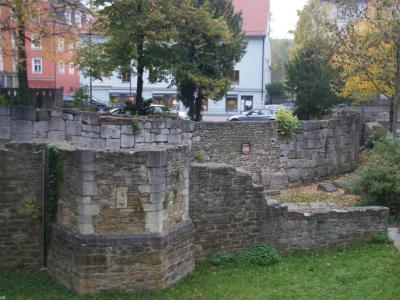Roman Ruins Walking Tour (Self Guided), Regensburg
Meandering through the Old Town of Regensburg, it’s easy to forget that some 1800 years ago most of this area was occupied by a Roman fortress. Although the first settlement here dates from as early as the Stone Age, it is the Romans who put it firmly on the map.
Around 90 AD, they first built an expeditionary and then a permanent military camp called Castra Regina ("Fortress by the River Regen"), in 179 AD, during the reign of Emperor Marcus Aurelius. Designed to accommodate the 3rd Italian Legion (Legio III Italica), the rectangular fort measured 540 x 450 meters and was fit to house up to 6,000 soldiers.
Important for its location, at the junction of the Danube and Regen rivers, this outpost formed part of the Roman Empire’s northern frontier (the so-called Danubian Limes) and corresponded roughly to what is now the core of Regensburg's Altstadt (Old Town). It was surrounded by a mighty wall comprising large ashlars with towers and a wide moat in front of it.
By the 3rd century AD, the camp had an extensive civilian suburb with residential and commercial buildings, shops, villas, sanctuaries, and a large bathing complex ("therme"). In the 5th century, constant Barbarian raids and migrations forced the Romans to abandon the fort, but the large ashlar wall of the legionary camp continued to protect the early medieval town long after they left. The east side of the fortress wall served as a city wall during the High Middle Ages and was repaired accordingly; hence the large portions thereof have been preserved.
Today, traces of the Roman-era buildings and remnants of the legionary camp fortifications are found both under and above ground in the heart of Regensburg. Perhaps the most prominent of them is the former north gate to Castra Regina, called Porta Praetoria, the largest surviving Roman building in Bavaria.
Other impressive relics include a long section of the Roman wall uncovered during the construction of a multi-story car park in Dachau Square (Dachauplatz), as well as fragments of the north- and south-east corners of the wall that once encircled the Roman camp. Together they are featured in the multimedia "Legion Camp Wall Document" ("Document Legionslagermauer”).
If Regensburg is "The Jewel of Bavaria", then Castra Regina is undoubtedly the jewel of its Roman part. To learn more about the Roman legacy of this former imperial outpost in the Danubian region, take our self-guided historical tour.
Around 90 AD, they first built an expeditionary and then a permanent military camp called Castra Regina ("Fortress by the River Regen"), in 179 AD, during the reign of Emperor Marcus Aurelius. Designed to accommodate the 3rd Italian Legion (Legio III Italica), the rectangular fort measured 540 x 450 meters and was fit to house up to 6,000 soldiers.
Important for its location, at the junction of the Danube and Regen rivers, this outpost formed part of the Roman Empire’s northern frontier (the so-called Danubian Limes) and corresponded roughly to what is now the core of Regensburg's Altstadt (Old Town). It was surrounded by a mighty wall comprising large ashlars with towers and a wide moat in front of it.
By the 3rd century AD, the camp had an extensive civilian suburb with residential and commercial buildings, shops, villas, sanctuaries, and a large bathing complex ("therme"). In the 5th century, constant Barbarian raids and migrations forced the Romans to abandon the fort, but the large ashlar wall of the legionary camp continued to protect the early medieval town long after they left. The east side of the fortress wall served as a city wall during the High Middle Ages and was repaired accordingly; hence the large portions thereof have been preserved.
Today, traces of the Roman-era buildings and remnants of the legionary camp fortifications are found both under and above ground in the heart of Regensburg. Perhaps the most prominent of them is the former north gate to Castra Regina, called Porta Praetoria, the largest surviving Roman building in Bavaria.
Other impressive relics include a long section of the Roman wall uncovered during the construction of a multi-story car park in Dachau Square (Dachauplatz), as well as fragments of the north- and south-east corners of the wall that once encircled the Roman camp. Together they are featured in the multimedia "Legion Camp Wall Document" ("Document Legionslagermauer”).
If Regensburg is "The Jewel of Bavaria", then Castra Regina is undoubtedly the jewel of its Roman part. To learn more about the Roman legacy of this former imperial outpost in the Danubian region, take our self-guided historical tour.
How it works: Download the app "GPSmyCity: Walks in 1K+ Cities" from Apple App Store or Google Play Store to your mobile phone or tablet. The app turns your mobile device into a personal tour guide and its built-in GPS navigation functions guide you from one tour stop to next. The app works offline, so no data plan is needed when traveling abroad.
Roman Ruins Walking Tour Map
Guide Name: Roman Ruins Walking Tour
Guide Location: Germany » Regensburg (See other walking tours in Regensburg)
Guide Type: Self-guided Walking Tour (Sightseeing)
# of Attractions: 5
Tour Duration: 1 Hour(s)
Travel Distance: 1.4 Km or 0.9 Miles
Author: DanaOffice
Sight(s) Featured in This Guide:
Guide Location: Germany » Regensburg (See other walking tours in Regensburg)
Guide Type: Self-guided Walking Tour (Sightseeing)
# of Attractions: 5
Tour Duration: 1 Hour(s)
Travel Distance: 1.4 Km or 0.9 Miles
Author: DanaOffice
Sight(s) Featured in This Guide:
- Museum of Bavarian History
- Northeast Corner Roman Wall Remaints
- Porta Praetoria (Praetorian Gate)
- "Document Legionslagermauer” in Dachau Square
- Southeast Corner of the Fortress Wall
1) Museum of Bavarian History
The Museum of Bavarian History tells the story of a region that has shaped—and been shaped by—centuries of transformation. Opened in 2019 to mark 100 years of the Bavarian Free State and 200 years of its first constitution, the museum stands proudly along the Danube, where Bavaria’s past flows into its present. Its location is no accident—Regensburg was once a political and cultural crossroads of medieval Bavaria, and today it continues that legacy through storytelling rather than statecraft.
Inside, visitors embark on a journey beginning in 1806, when Bavaria became a kingdom under Maximilian I Joseph. From there, the exhibitions unfold through moments of triumph and turmoil: alliances with Napoleon, the flowering of culture in Munich, the industrial revolution, the devastation of world wars, and the resilience that forged modern Bavaria. Instead of dry timelines, the museum fills its galleries with personal stories, interactive displays, and artifacts that reveal how ordinary Bavarians lived, worked, and dreamed through the ages.
A favorite among visitors is the panoramic window overlooking the Danube—a living metaphor for the flow of history. Nearby, an ancient Roman inscription from 179 AD reminds guests that Regensburg’s story began long before Bavaria itself existed. One guide likes to say that “Bavaria remembers in layers,” and nowhere is that truer than here, where past and present overlap in every room.
For travelers, the Museum of Bavarian History offers more than facts—it invites reflection on identity, endurance, and what it means to belong to a place that has outlasted empires.
Inside, visitors embark on a journey beginning in 1806, when Bavaria became a kingdom under Maximilian I Joseph. From there, the exhibitions unfold through moments of triumph and turmoil: alliances with Napoleon, the flowering of culture in Munich, the industrial revolution, the devastation of world wars, and the resilience that forged modern Bavaria. Instead of dry timelines, the museum fills its galleries with personal stories, interactive displays, and artifacts that reveal how ordinary Bavarians lived, worked, and dreamed through the ages.
A favorite among visitors is the panoramic window overlooking the Danube—a living metaphor for the flow of history. Nearby, an ancient Roman inscription from 179 AD reminds guests that Regensburg’s story began long before Bavaria itself existed. One guide likes to say that “Bavaria remembers in layers,” and nowhere is that truer than here, where past and present overlap in every room.
For travelers, the Museum of Bavarian History offers more than facts—it invites reflection on identity, endurance, and what it means to belong to a place that has outlasted empires.
2) Northeast Corner Roman Wall Remaints
The Northeast Corner Roman Wall Remains provide a fascinating glimpse into the ancient history of the city. These remnants, situated on Saint George Square, stand up to 10 feet (3 meters) in height and are a testament to the former legionary fortress wall.
The discovery of these remains took place in 1905 during the demolition of the pawnbroker department's accounting offices, which were located next to the high medieval Haller Gate. The demolition process not only revealed the northeast corner of the Roman wall but also uncovered the east side of the Saint George and Afra Chapel, including its Romanesque window.
While the outer facing ashlars have not been preserved, the surviving masonry provides valuable insights into the original construction. The irregularly placed stones make it difficult to identify specific components from the original construction period, such as a relatively flat front, a protruding podium, or the beginnings of a corner tower. Instead, the remaining stone blocks likely belonged to the inner face of the broad ashlar masonry.
Despite the absence of some key architectural elements, the Northeast Corner Roman Wall Remains offer a tangible link to the past. Standing tall on Saint George Square, they serve as a reminder of the ancient Roman presence in Regensburg and provide a fascinating glimpse into the city's historical development. Visitors can marvel at these ancient remnants and imagine the grandeur of the former legionary fortress wall that once surrounded the area.
The discovery of these remains took place in 1905 during the demolition of the pawnbroker department's accounting offices, which were located next to the high medieval Haller Gate. The demolition process not only revealed the northeast corner of the Roman wall but also uncovered the east side of the Saint George and Afra Chapel, including its Romanesque window.
While the outer facing ashlars have not been preserved, the surviving masonry provides valuable insights into the original construction. The irregularly placed stones make it difficult to identify specific components from the original construction period, such as a relatively flat front, a protruding podium, or the beginnings of a corner tower. Instead, the remaining stone blocks likely belonged to the inner face of the broad ashlar masonry.
Despite the absence of some key architectural elements, the Northeast Corner Roman Wall Remains offer a tangible link to the past. Standing tall on Saint George Square, they serve as a reminder of the ancient Roman presence in Regensburg and provide a fascinating glimpse into the city's historical development. Visitors can marvel at these ancient remnants and imagine the grandeur of the former legionary fortress wall that once surrounded the area.
3) Porta Praetoria (Praetorian Gate)
The Praetorian Gate is Regensburg’s oldest surviving witness to its Roman beginnings and one of the oldest stone structures in Germany. Built in 179 AD under Emperor Marcus Aurelius, it once formed the northern gate of Castra Regina—“the Fortress by the River Regen”—the Roman stronghold guarding the empire’s frontier along the Danube. Through this gateway marched the soldiers of the Third Legion, sent to defend Rome’s borders and control vital trade routes.
They say that when Frankish king Charlemagne passed through Regensburg centuries later, he marveled at the gate’s stones, already weathered with age, recognizing it as a remnant of the empire that had once ruled Europe. Today, those same limestone blocks, marked by Latin inscriptions and centuries of wear, still hold their place—embedded in medieval walls, half-hidden among shops and cafés along Unter den Schwibbögen Street. It’s easy to miss at first glance, but once noticed, it draws you into a moment of quiet awe.
Standing beneath the arch, visitors can almost hear the rhythm of Roman footsteps, the clatter of armor, and the calls of soldiers heading toward the Danube. The Praetorian Gate has seen nearly two millennia of change—wars, merchants, emperors, and tourists—yet it endures, a silent sentinel watching the city evolve around it. More than a ruin, it’s a meeting point between eras, where Regensburg’s ancient past still breathes within its modern streets.
They say that when Frankish king Charlemagne passed through Regensburg centuries later, he marveled at the gate’s stones, already weathered with age, recognizing it as a remnant of the empire that had once ruled Europe. Today, those same limestone blocks, marked by Latin inscriptions and centuries of wear, still hold their place—embedded in medieval walls, half-hidden among shops and cafés along Unter den Schwibbögen Street. It’s easy to miss at first glance, but once noticed, it draws you into a moment of quiet awe.
Standing beneath the arch, visitors can almost hear the rhythm of Roman footsteps, the clatter of armor, and the calls of soldiers heading toward the Danube. The Praetorian Gate has seen nearly two millennia of change—wars, merchants, emperors, and tourists—yet it endures, a silent sentinel watching the city evolve around it. More than a ruin, it’s a meeting point between eras, where Regensburg’s ancient past still breathes within its modern streets.
4) "Document Legionslagermauer” in Dachau Square
Located in the Dachau Square is the impressive "Document Legionslagermauer." This remarkable site can be explored through a captivating digital presentation at the information center situated in the basement of the car park. To access it, visitors can use the staircase accessible from Königs Street.
Within this underground space, a section of the fortification measuring approximately 230 feet (70 meters) in length and up to five ashlar layers high has been preserved. This represents the longest remaining straight segment of the Roman wall in existence.
As you descend the steep staircase into the basement, you'll immediately notice the variation in height between the Roman habitation layer, indicated by the wall's podium, and the current street level. This eastern section of the legionary fortress once formed part of the city walls until the early fourteenth century when it was repurposed for the convent of the Poor Clares and eventually filled in. Although the ashlars undoubtedly originate from the Roman period, modifications and repairs from later periods are discernible.
On the car park basement wall, across from the Roman wall, you'll find a regular-sized and a large monitor displaying a twelve-minute video presentation. This video provides insights into the legionary fortress wall, with a particular focus on the uncovering and details of this specific section. Additionally, there is another video explaining the construction history of the southeast corner of the Roman wall.
Within this underground space, a section of the fortification measuring approximately 230 feet (70 meters) in length and up to five ashlar layers high has been preserved. This represents the longest remaining straight segment of the Roman wall in existence.
As you descend the steep staircase into the basement, you'll immediately notice the variation in height between the Roman habitation layer, indicated by the wall's podium, and the current street level. This eastern section of the legionary fortress once formed part of the city walls until the early fourteenth century when it was repurposed for the convent of the Poor Clares and eventually filled in. Although the ashlars undoubtedly originate from the Roman period, modifications and repairs from later periods are discernible.
On the car park basement wall, across from the Roman wall, you'll find a regular-sized and a large monitor displaying a twelve-minute video presentation. This video provides insights into the legionary fortress wall, with a particular focus on the uncovering and details of this specific section. Additionally, there is another video explaining the construction history of the southeast corner of the Roman wall.
5) Southeast Corner of the Fortress Wall
The southeast corner of the former Roman fortress holds historical significance and is now a part of the "document Legionslagermauer." Through archaeological excavations carried out in 1955 and 1961, a large conservation zone was established, allowing for a remarkable glimpse into the structure of the Roman fort's wall.
During that time, Horst Bergschneider, a notable resident of Regensburg, played a crucial role in fundraising and raising awareness for the preservation of the Roman wall at this particular location. His dedication and efforts were commendable and had a significant impact.
Exploring this area, visitors can witness the impressive curvature of the southeast corner of the legionary fortress, which seamlessly connects to the northward and westward extensions of the legionary wall. Notably, the remains of the podium with its characteristic slant are still visible. At the top of the curve, there is a rubble wall, likely added during the Middle Ages to replace a protruding corner tower.
Towards the north, the ruins of a medieval fortified tower merge with the Roman masonry, demonstrating the transition from Roman to medieval fortification at this site. This combination emphasizes the remnants of the lower bailey, including a tower dating back to 1389.
Interestingly, both of these walls continued to serve their defensive purpose until the early 19th century. Only after Regensburg was bombarded and attacked by Napoleonic troops in 1809 did their defensive role diminish. As a result, large portions of the walls were removed and filled in, contributing to the protection of the lower section of the Roman wall.
During that time, Horst Bergschneider, a notable resident of Regensburg, played a crucial role in fundraising and raising awareness for the preservation of the Roman wall at this particular location. His dedication and efforts were commendable and had a significant impact.
Exploring this area, visitors can witness the impressive curvature of the southeast corner of the legionary fortress, which seamlessly connects to the northward and westward extensions of the legionary wall. Notably, the remains of the podium with its characteristic slant are still visible. At the top of the curve, there is a rubble wall, likely added during the Middle Ages to replace a protruding corner tower.
Towards the north, the ruins of a medieval fortified tower merge with the Roman masonry, demonstrating the transition from Roman to medieval fortification at this site. This combination emphasizes the remnants of the lower bailey, including a tower dating back to 1389.
Interestingly, both of these walls continued to serve their defensive purpose until the early 19th century. Only after Regensburg was bombarded and attacked by Napoleonic troops in 1809 did their defensive role diminish. As a result, large portions of the walls were removed and filled in, contributing to the protection of the lower section of the Roman wall.
Walking Tours in Regensburg, Germany
Create Your Own Walk in Regensburg
Creating your own self-guided walk in Regensburg is easy and fun. Choose the city attractions that you want to see and a walk route map will be created just for you. You can even set your hotel as the start point of the walk.
Regensburg Introduction Walking Tour
During a battle in 1809, Napoleon remarked that Regensburg was “worth a crown.”
The name “Regensburg” reflects its roots: it comes from the River Regen, which joins the Danube here, and the Old High German word burg, meaning fortress—so Regensburg means “the fortress by the Regen.”
Long before the Romans, Celtic tribes had already settled on the high ground, taking advantage of... view more
Tour Duration: 2 Hour(s)
Travel Distance: 4.1 Km or 2.5 Miles
The name “Regensburg” reflects its roots: it comes from the River Regen, which joins the Danube here, and the Old High German word burg, meaning fortress—so Regensburg means “the fortress by the Regen.”
Long before the Romans, Celtic tribes had already settled on the high ground, taking advantage of... view more
Tour Duration: 2 Hour(s)
Travel Distance: 4.1 Km or 2.5 Miles
The Most Popular Cities
/ view all









